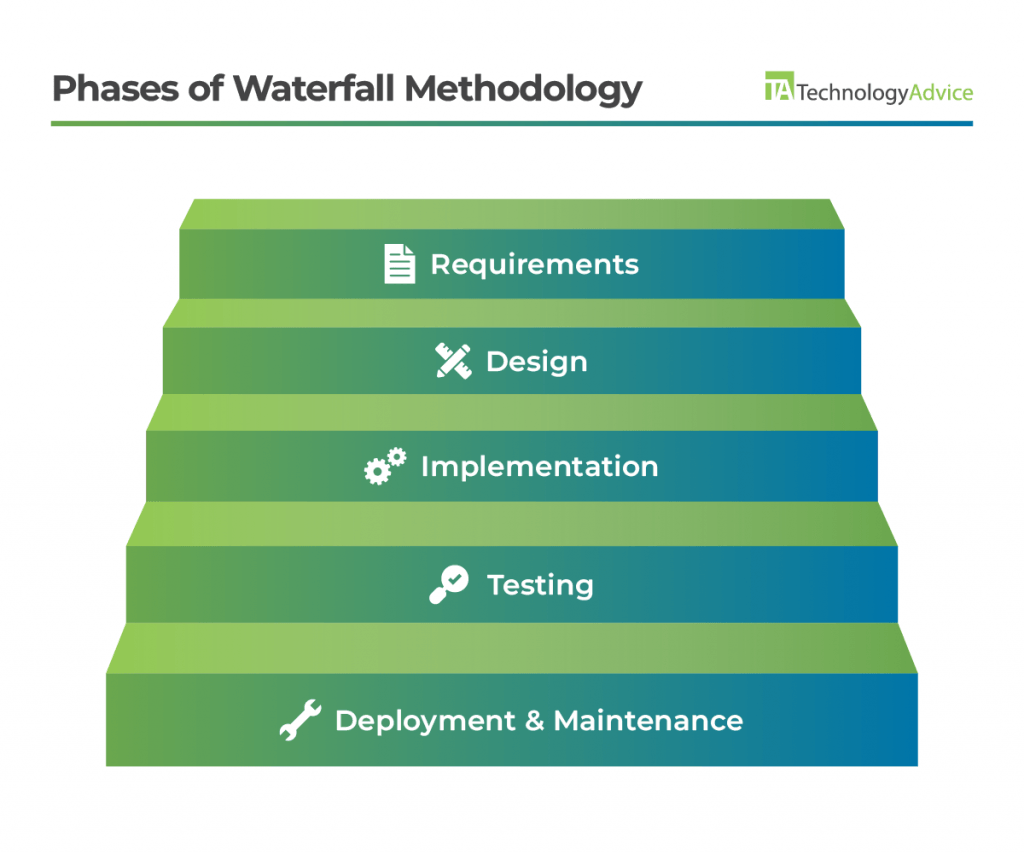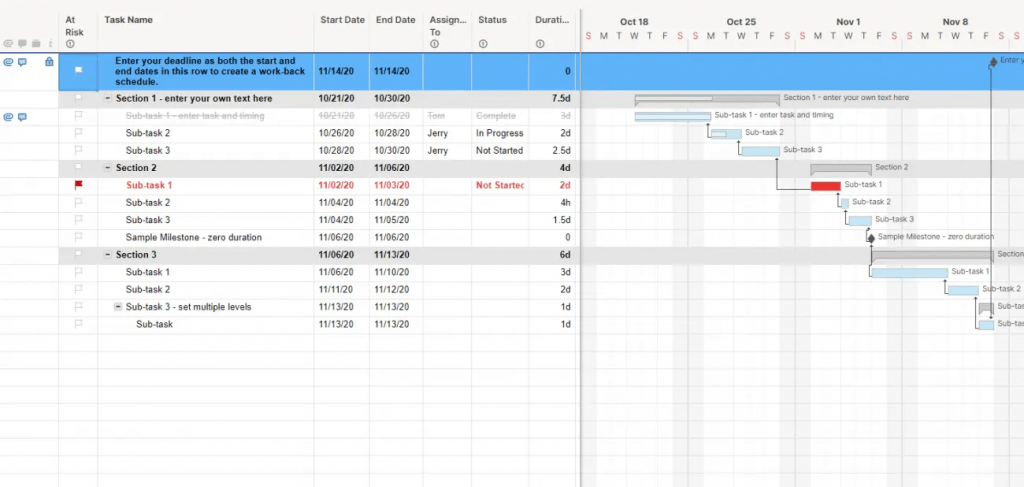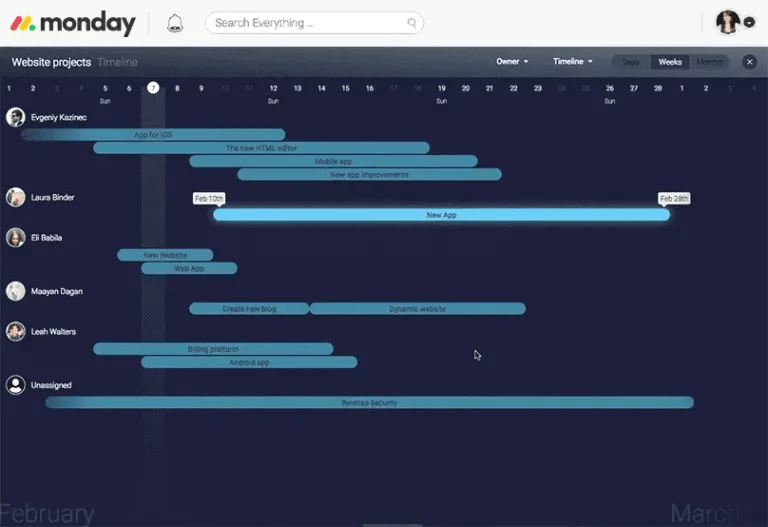Project Management
Key takeaways
In this article…
Waterfall project management definition
Waterfall project management is a methodology characterized by a linear and sequential design process. This approach is akin to a cascading waterfall, hence its name, where each project phase cascades into the next. The methodology is structured so that each project stage must be completed before the next one begins for a systematic and orderly progression through the project lifecycle.
The waterfall model is particularly well-suited for projects where the objectives and deliverables are clearly defined. Each phase in the waterfall process relies heavily on the deliverables and feedback of the preceding phase. This process creates a dependent chain of development stages.
Since the waterfall model is predicated on a foundation of well-defined requirements, any deviation or alteration in the plan requires revisiting and potentially redoing previous work. This can be time-consuming and costly, as it disrupts the project flow and requires a backtrack to earlier stages — a process that the waterfall methodology does not inherently accommodate.
The phases of the waterfall methodology
The waterfall methodology consists of five distinct phases that are linear and rigid: requirements, design, implementation, testing, and deployment and maintenance.

Learn how projects unfold from start to finish across methodologies: The Five Phases of Project Management
Requirements
In the requirements phase of the waterfall methodology, the project’s foundation is laid out with a comprehensive outline of the project’s requirements. This stage is crucial as it involves defining high-level statements of what the project must achieve, which could be implemented in various ways. These requirements may include project scope, stakeholder expectations, and research.
Smartsheet aids the requirements phase of waterfall project management by providing a collaborative, real-time platform for documenting project specifications. Its customizable templates help in structuring the diverse needs of a project, while the attachment feature makes sure all related files are centrally accessible.
Automated workflows streamline the approval process, and integration capabilities with other tools enhance efficiency. Smartsheet also has strong access controls and reporting tools that give project managers precise control over the requirements documentation process.

Design
Following the establishment of requirements, the design phase involves creating solution strategies that meet the outlined requirements. This phase is pivotal in translating requirements into detailed specifications and plans. It’s where theoretical requirements take a practical shape, whether through architectural diagrams, data models, or detailed design documents. The deliverables from this phase typically include design specifications and potentially prototype models, which are reviewed to confirm they align with the requirements before proceeding to implementation.
In this phase, Microsoft Project can help in meticulous project planning and tracking the design activities through its Gantt charts and scheduling features. These features make sure that each design element is accounted for and completed on time. It allows for allocating resources to specific design tasks, monitoring their progress against the project timeline, and adjusting as necessary to adhere to deadlines.
The software’s critical path feature is particularly beneficial for identifying and managing tasks that could delay the project. At the same time, its centralized platform fosters collaboration among stakeholders.
Implementation
The implementation phase is where the actual construction of the project takes place based on the design documents and specifications. It’s a critical phase where the project starts to materialize through coding, development, and the integration of components.
The importance of this phase lies in its role in turning design concepts into a working product or system. Deliverables include the developed software or completed components of the project, which are reviewed for adherence to design specifications and readiness for the subsequent testing phase.
During the implementation phase of waterfall project management, Jira can act as a central hub for task management. Its features allow for meticulous tracking of development progress. It enables the creation of a detailed workflow for issues, assignment of work to developers, and prioritization of features and bugs.
The ability to integrate with version control systems like Git further enhances Jira’s utility, linking code commits to tasks for better traceability. This, coupled with Jira’s reporting tools, offers project managers a clear view of progress and helps maintain strict adherence to the project timeline.
Testing
During the testing phase, the implementation outcomes are rigorously evaluated to make sure they meet the initial requirements and design specifications. This phase is essential for verifying the functionality, performance, and reliability of the project deliverables.
Testing can include various methods, such as unit testing, integration testing, system testing, and user acceptance testing. The deliverables from this phase are test reports, which detail the testing processes and results. These reports are reviewed to confirm that the project is ready for deployment or to identify any issues that need to be addressed.
Deployment and maintenance
Finally, the deployment and maintenance phase sees the project being put into production and maintained over time. This phase is significant as it involves not only the actual launch of the project into a live environment but also the ongoing support and enhancement to guarantee its continued effectiveness.
Deliverables include the final product, release notes, and maintenance plans. Reviews during this phase focus on the project’s performance in the real world and the implementation of any necessary updates or fixes to maintain its viability and efficiency.
During the deployment and maintenance phase of the waterfall methodology, monday.com supports the rollout and ongoing management of the project. It can help in meticulously tracking the deployment process, coordinating release schedules, and managing immediate post-launch tasks.
The platform’s ability to handle task assignments, prioritize maintenance issues, and facilitate team communication makes it an asset for securing the project’s stability and responsiveness to any arising issues.

Who is waterfall project management best for?
The waterfall project management process is best for rigidly structured projects. The clear communication and expectations of the waterfall methodology reduce confusion and keep things relatively on track. But it only works for projects with those clear steps—anything that requires unexpected shifts or new ideas will need a different method.
Construction projects, for example, are almost entirely built around difficult-to-ignore dependencies. Framing must be done before detailing, and electrical wiring should be installed before the drywall goes up. These natural dependencies make it an excellent fit for waterfall’s planning and strict process. The same could be said for the fulfillment and logistics industries.
The waterfall method does create a process that is relatively simple to triage because every task and dependency is already laid out in a readily accessible document. But it can only accommodate minimal changes that are absolutely necessary. Otherwise, the timeline would have to be redone entirely, which could cost the team a lot of time and effort.
So again, if you deal with constant priorities and task shifts, similar to a newsroom, you’ll need something much more flexible than the waterfall methodology.
When is waterfall methodology less successful?
The waterfall methodology may not be the best fit for all project management scenarios. Its rigidity can be a double-edged sword; on one hand, it provides a clear structure and milestones, but on the other, it cannot adapt to changes once the project is underway. As previously mentioned, this can lead to high costs if changes are needed late in the project, as going back to a previous phase is not part of the waterfall ethos.
Additionally, because testing is left until after the completion of all prior phases, any issues discovered late in the process can cause significant delays and increase costs. This makes waterfall unsuitable for projects where requirements are not well understood from the outset or are likely to evolve.
Organizations or projects that demand frequent reassessment, such as tech startups working on innovative software, may find waterfall methodology challenging. This is because it is hard to predict all the needs and requirements, and things can change significantly over time.
For instance, a company developing a new software product in a rapidly evolving market would likely find using the waterfall methodology a hindrance, as its inability to amend changes quickly could result in an outdated product by the time of release.
How is waterfall project management different from other PM methodologies?
Is waterfall project management right for you?
Understanding whether waterfall project management fits your needs is crucial because it can significantly impact the success of your project. Factors such as the project timeline, scope, team expertise, budget, and level of client involvement play vital roles in this determination.
Waterfall is ideal for projects with a well-defined scope and requirements that are unlikely to change. It works well when the timeline and budget are fixed and the team has the expertise to deliver the project without future iterations. Additionally, waterfall can be beneficial when client involvement is limited to the beginning and end of the project, as it doesn’t cater to continuous client engagement.
Assess whether waterfall’s sequential, phased approach aligns with your project’s requirements — particularly its resource constraints and expected outcomes. If your project demands a structured approach with clear documentation and upfront planning that isn’t subject to change, then waterfall could be the right choice.
Intrigued by the various PM approaches beyond waterfall? Learn more about other top innovative project management strategies.
About the author


